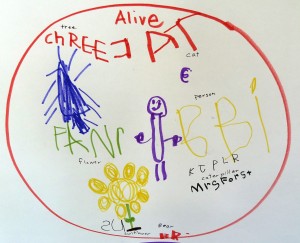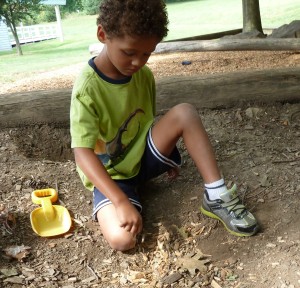Now that we can [hopefully] expect to have frost-free evenings here in Western Pennsylvania, we’ve begun to explore our growing world outside. Our first question was how to identify something that is alive vs. something that is not. We decided that things that are alive need to breathe and grow. (Please note that, thankfully, one of the children put me on the list.)

Many items on our list were creatures, but a few were of the plant variety. We talked about the differences between plants and creatures and tried to figure out how plants eat and drink. To help us with this problem, we invited a new friend to join us.

We tried to think up a name for him, but the children lost interest after they tried to name him “Brown Head” and I suggested that a name doesn’t always describe someone. Oops. I guess I should have left well enough alone on that one. Instead, we decided that we should all make a new friend to share our class with.

The children have been helping with the care of their freshly planted grass seeds by spritzing them with water on a daily basis. One child suggested today, “If I give it lots and lots of water, I bet it will grow really, really big!” I asked him how well he would grow under water. Of course he said that he couldn’t possibly live under water because he needed air. There was almost an audible Ding! when he made the connection that the plant needed air, too.
When the children arrived this morning, I heard exclamations of “Look at my friends hair!” and “It’s growing! It’s growing!” We’ve been looking at the roots from the grass seeds along the sides of the cups for a day or two, so it was quite exciting to finally see some green poking out of the top of the cup. Señora Sewald has been helping us understand the structure of a plant by making a collage using real plant parts. Of course the children practiced saying roots, stem, leaves, and flower in Spanish, too. Now they can see their own living versions of the collage.

 Gritty, dusty, grimy first-hand experience. That is what defines our time outdoors. As a few children searched for worms today, they had many variables to work with.
Gritty, dusty, grimy first-hand experience. That is what defines our time outdoors. As a few children searched for worms today, they had many variables to work with.



